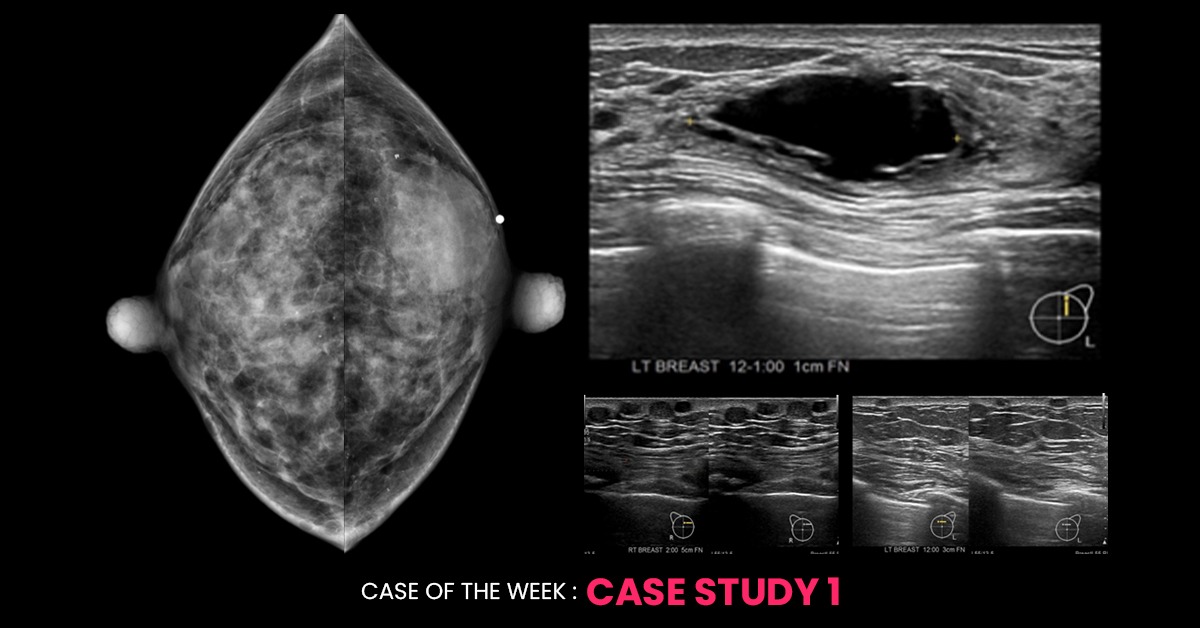Mail Us
contact@biedx.com

Beneath the area of palpable concern in the left breast, an oval, circumscribed, isodense mass is evident on the mammogram. Ultrasound examination reveals a cyst in the left breast, correlating with this lesion. Additionally, numerous round, circumscribed, fat-density lesions are diffusely distributed in both breasts. The differentials include multiple sebaceous cysts or free fat injection. Ultrasound examination reveals bilateral, multiple, circumscribed, iso to hypoechoic masses in the intradermal layer in both breasts, correlating with these fat density lesions observed on the mammogram. This confirms the lesions as multiple sebaceous cysts, a condition known as “Steatocystoma Multiplex.”
For more information on the imaging features and clinical details of this condition, refer to https://onlinelibrary.wiley.com/doi/10.1111/tbj.14179 and https://pubmed.ncbi.nlm.nih.gov/33527591/.
A simple clinical examination of the patient may reveal multiple small cutaneous lesions on the chest, arm, and occasionally other parts of the body, aiding in clinching the diagnosis. As this condition is autosomal dominant, a similar family history may be present. Steatocystoma Multiplex is benign and typically does not require intervention or follow-up. Therefore, the final BI-RADS assessment in this patient will be BI-RADS 2 (Benign condition). Aspiration of the palpable left breast cyst may be offered for symptomatic relief if clinically indicated.
Steatocystoma multiplex is a rare skin disorder characterized by the development of multiple noncancerous (benign) cysts known as steatocystomas. These growths originate in the skin’s sebaceous glands, responsible for producing sebum to lubricate the skin and hair.
In affected individuals, steatocystomas typically emerge during adolescence and are commonly found on the torso, neck, upper arms, and upper legs. While these cysts are the primary manifestation of the condition, some individuals may also exhibit mild abnormalities in teeth or nails.
Steatocystoma multiplex can result from mutations in the *KRT17* gene, which encodes keratin 17—a protein found in nails, hair follicles, and the skin on palms and soles. Although most cases are sporadic, the disorder can be inherited in an autosomal dominant pattern.
The prognosis for patients with steatocystoma multiplex is generally favorable, given its benign nature and absence of malignant transformation. Treatment options include oral isotretinoin, surgical excision, and physical therapies like CO2 laser and cryotherapy. While some cases may involve inflammation and cyst rupture, they typically remain asymptomatic.
Steatocystoma multiplex, while rare, is a well-characterized skin disorder primarily affecting sebaceous glands. It manifests with multiple benign cysts and can occur sporadically or be inherited. Management strategies focus on symptom alleviation and cosmetic improvement, with a generally positive outlook for affected individuals.
To provide state-of-the-art education and career growth to radiologists and surgeons for improved patient care through wide availability of highly skilled doctors.
Copyright © 2025 All rights reserved.